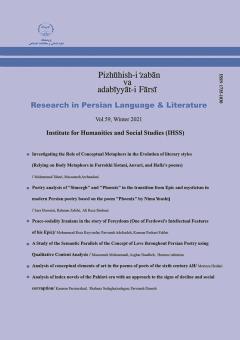-
-
List of Articles
-
Open Access Article
1 - Investigating the Role of Conceptual Metaphors in the Evolution of literary styles (Relying on Body Metaphors in Farrokhi Sistani, Anvari, and Hafiz's poems)
Mohammad Taheri Masoumeh Archandani -
Open Access Article
2 - Poetry analysis of "Simorgh" and "Phoenix" in the transition from Epic and mysticism in modern Persian poetry based on the poem "Phoenix" by Nima Youshij
sara hosseini rahman zabihi alireza shohani -
Open Access Article
3 - Peace-sodality Iranians in the story of Fereydoun (One of Ferdowsi's Intellectual Features of his Epic)
mohammad reza Keyvanfar Parvaneh A’del Zadeh kamran pashaei fahkri -
Open Access Article
4 - A Study of the Semantic Parallels of the Concept of Love throughout Persian Poetry using Qualitative Content Analysis
masoume mohammadi Asghar Daadbeh Hormoz Rahimhan -
Open Access Article
5 - Analysis of conceptual elements of art in the poems of poets of the sixth century AH
Morteza Heidari -
Open Access Article
6 - Analysis of index novels of the Pahlavi era with an approach to the signs of decline and social corruption
kamran parsinejad Shahnaz Sedaghatzadegan Parvaneh Danesh
-
The rights to this website are owned by the Raimag Press Management System.
Copyright © 2017-2025







